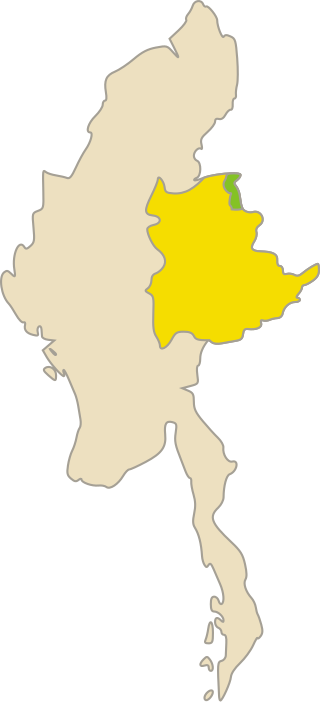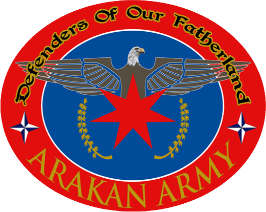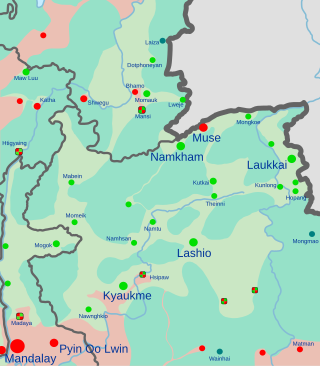
Kokang is a region in Myanmar. It is located in the northern part of Shan State, with the Salween River to its west, and sharing a border with China's Yunnan Province to the east. Its total land area is around 1,895 square kilometers (732 sq mi). The capital is Laukkai. Kokang is mostly populated by Kokang Chinese, a Han Chinese group living in Myanmar.

Insurgencies have been ongoing in Myanmar since 1948, the year the country, then known as Burma, gained independence from the United Kingdom. The conflict has largely been ethnic-based, with several ethnic armed groups fighting Myanmar's armed forces, the Tatmadaw, for self-determination. Despite numerous ceasefires and the creation of autonomous self-administered zones in 2008, many armed groups continue to call for independence, increased autonomy, or the federalisation of the country. The conflict is the world's longest ongoing civil war, having spanned more than seven decades.

The Kokang incident was a violent series of skirmishes that broke out in August 2009 in Kokang in Myanmar's northern Shan State. Several clashes between ethnic minorities and the Burmese military junta forces took place. As a result of the conflict, the MNDAA lost control of the area and as many as 30,000 refugees fled to Yunnan province in neighbouring China.
Laukkai is the capital of Kokang Self-Administered Zone in the northern part of Shan State, Myanmar. It is located east of the Salween River, which forms part of Myanmar's border with the People's Republic of China at its upper reaches. It is about 10 miles (16 km) away from Nansan, China. In Laukkai, Southwestern Mandarin and Chinese characters are widely used, and the Chinese renminbi is in circulation. It is the main town of Laukkaing Township of the Kokang Self-Administered Zone. It is 117 miles (188 km) from Lashio and 42 miles (68 km) from Kongyan. Its population is 23,435. Laukkai is notorious for its gambling, prostitution, human trafficking and online scams.
Pheung Kya-shin was the chairman of the Shan State Special Region No. 1 in Myanmar (Burma) and the leader of the Myanmar National Democratic Alliance Army (MNDAA) from 1989 to 2009.

The Kokang Self-Administered Zone, as stipulated by the 2008 Constitution of Myanmar, is a self-administered zone in northern Shan State. The zone is intended to be self-administered by the Kokang people. Its official name was announced by decree on 20 August 2010. It is recognized as illegal by the Myanmar National Democratic Alliance Army (MNDAA).
The 2010–2012 Myanmar border clashes were a series of skirmishes between the Tatmadaw on one side, and the DKBA-5 and the Karen National Liberation Army (KNLA) on the other. The clashes erupted along the border with Thailand shortly after Myanmar's general election on 7 November 2010. An estimated 10,000 refugees have fled into nearby neighbouring Thailand to escape the violent conflict. There was concern that due to discontent with the elections, and speculations of electoral fraud, that the conflict could escalate into a civil war.
Ceasefires in Myanmar have been heavily utilized by the Burmese government as a policy to contain ethnic rebel groups and create tentative truces. The first ceasefire was arranged by the State Law and Order Restoration Council in 1989, specifically spearheaded by Khin Nyunt, then the Chief of Military Intelligence, with the Kokang-led National Democratic Alliance Army, which had recently split from the Communist Party of Burma due to internal conflicts.

The Kachin conflict or the Kachin War is one of the multiple conflicts which are collectively referred to as the internal conflict in Myanmar. Kachin insurgents have been fighting against the Tatmadaw since 1961, with only one major ceasefire being brokered between them, which lasted from 1994 to 2011, a total of 17 years.

The Arakan Army, officially the Arakha Army is an ethnic armed organisation based in Rakhine State (Arakan). Founded on 10 April 2009, the AA is the military wing of the United League of Arakan (ULA). It is currently led by Commander-in-Chief Major General Twan Mrat Naing and vice deputy commander-in-chief Brigadier General Nyo Twan Awng. The Arakan Army states that the objective of its armed revolution is to restore the sovereignty of the Arakan people. In a February 2024 interview, Twan Mrat Naing claimed that the AA had grown to at least 38,000 troops. Anthony Davis, an expert of military and security, rejected this claim and estimated that it has at least 15,000 troops in Chin State and Rakhine State, in addition to around 1500 in Kachin State and Shan State. In the early 2010s, the Arakan Army fought alongside the Kachin Independence Army (KIA) against the Tatmadaw in the Kachin conflict. Following the 2016 outbreak of conflict in Rakhine state, AA became more heavily involved in the Arakan region. In 2019, AA launched attacks on state security forces and the Myanmar Army responded, heightening clashes. The AA reached a ceasefire in late 2020 after eroding the central government's control in northern Rakhine. The power vacuum was filled by the AA over the next 18 months with state-building efforts, like their COVID-19 vaccine rollouts.

The Myanmar National Democratic Alliance Army (MNDAA) is an armed resistance group in the Kokang region of Myanmar (Burma). The army has existed since 1989, having been the first one to sign a ceasefire agreement with the Burmese government. The ceasefire lasted for about two decades.
Bai Suocheng or Bai Xuoqian is a Kokang politician from Shan State, Myanmar. He was a former deputy commander of the Myanmar Nationalities Democratic Alliance Army who later became the MP of the Amyotha Hluttaw representing Laukkai and first leader of the Kokang Self-Administered Zone. In 2024 he was extradited to China for running online and telephone scam centres.

The Ta'ang National Liberation Army in Myanmar (Burma), is the armed wing of the Palaung State Liberation Front (PSLF).
The Muse offensive, also known as the Mong Ko offensive, was a joint military operation by members of the Northern Alliance, consisting of the Arakan Army (AA), the Kachin Independence Army (KIA), the Myanmar National Democratic Alliance Army (MNDAA) and the Ta'ang National Liberation Army (TNLA). The groups targeted towns and border posts along the China–Myanmar border in Muse Township, Myanmar.

The Myanmar civil war, also called the Burmese Spring Revolution, Burmese civil war or People's Defensive War, is an ongoing civil war following Myanmar's long-running insurgencies, which escalated significantly in response to the 2021 military coup d'état and the subsequent violent crackdown on anti-coup protests. The exiled National Unity Government and major ethnic armed organisations repudiated the 2008 Constitution and called instead for a democratic federal state. Besides engaging this rebel alliance, the junta also contends with other anti-junta forces in areas under its control. Hannah Beech of The New York Times observed the insurgents are apportioned into hundreds of armed groups scattered across the country.
The following is a timeline of major events during the Myanmar civil war (2021–present), following the 2021 military coup d'état and protests. It was also a renewed intensity in existing internal conflict in Myanmar.

Operation 1027 is an ongoing military offensive conducted by the Three Brotherhood Alliance, a military coalition composed of three ethnic armed organisations in Myanmar: the Arakan Army (AA), Myanmar National Democratic Alliance Army (MNDAA), and Ta'ang National Liberation Army (TNLA), allied with other rebel forces in the country, against the Tatmadaw, Myanmar's ruling military junta.
The Three Brotherhood Alliance ;, also known as Brotherhood Alliance, is an alliance between the Arakan Army, Myanmar National Democratic Alliance Army, and the Ta'ang National Liberation Army formed in June 2019.
Peng Daxun, also known as Peng Deren, is a Burmese Kokang military leader serving as commander of the Myanmar National Democratic Alliance Army (MNDAA) since 2009. He is the son of Pheung Kya-shin, his immediate predecessor as commander of the MNDAA, and has waged a war against the Tatmadaw and government of Myanmar to reclaim control over Kokang.

The Battle of Laukkai was a military offensive conducted by the Myanmar National Democratic Alliance Army (MNDAA) encircling and capturing Laukkai, the capital of the Kokang Self-Administered Zone in northeastern Myanmar. The battle was part of the larger Operation 1027, a joint military operation conducted by the Three Brotherhood Alliance coalition of three ethnic armed organisations and part of the overall renewed civil war in Myanmar.









